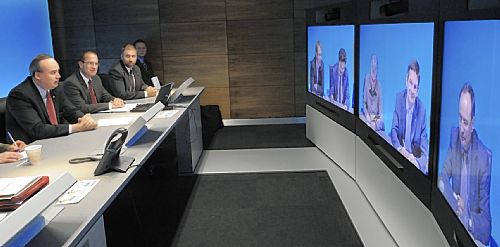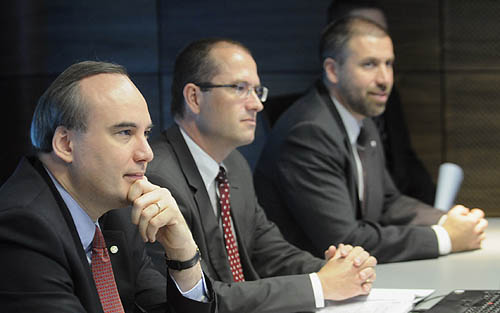|
Kaum ist Klaus in den USA, so
erscheint er schon in der örtlichen Presse in der Pittsburgh Post-Gazette und
zeitgleich in der Rheinischen Post in Leverkusen. |
|
Sunday, May 17, 2009

As eight Bayer managers gathered Monday to talk about environmental and energy issues, rain fell on the company's global headquarters in Leverkusen, Germany, where five sat, while there were clear skies over Pittsburgh where the other three were in Bayer's U.S. headquarters. Though separated by an ocean and a six-hour time difference, the executives used a cutting-edge teleconferencing system to chat in real time and watch each other's life-size images on screens that created the effect of being at the same conference table down to the bottled water, coffee cups and laptops. Bayer hooked up its first "telepresence" link, as the system is called, between Germany and the U.S. in December as part of a long-range corporate plan to reduce carbon emissions generated by travel and to develop more energy-efficient methods for conducting business worldwide. But as the company seeks ways to cut costs in the wake of the global economic collapse, demand among Bayer personnel for the technology has ratcheted up considerably. "I'm using it to run the business," said Claudio Abreu, president and chief executive of Bayer Business and Technology Services. He is based at Bayer's U.S. headquarters in Robinson but holds regular telepresence meetings with executives in Germany and elsewhere. "Not too many people want to travel globally every other week for a two-hour meeting." Forced to slash travel budgets as the sluggish economy continues, companies are finding that alternatives such as teleconferences, video conferences, Internet broadcasts and other Web-based meeting events can sometimes be as effective -- and definitely cheaper -- than meeting in person. Based on a survey released last week, 87 percent of companies in North America, Europe, Asia and Australia are spending less on business travel this year because of the financial downturn and 44 percent plan to cut travel spending by 10 percent or more. The survey of 285 companies, conducted by American Express' Global Commercial Card Group and CFO Research Services, also said senior managers -- including chief executives -- were increasingly involved in approving travel expenditures. Bayer estimates the one-time cost to set up a studio using the telepresence system developed by Norwegian company Tandberg ranges from $270,000 to $400,000. Once up and running, the hourly cost is about $500 for six executives in the room. That compares with about $2,700 per person for a business trip from Pittsburgh to Germany, by Bayer calculations. By the end of this month, the company plans to install similar systems at its facilities in Monheim, Germany; Lyon, France; and Raleigh, N.C., with more locations including Berlin, Singapore and Brazil on the drawing board. "You forget you are thousands of miles away," said Mr. Abreu. "You work like you're face to face across the table, which is much better decision making. You see people's reaction and behavior." Ariba, a California-based firm with a large Pittsburgh presence that provides software and other solutions to help companies manage spending, said it saved $300,000 by holding its annual conference for customers online last month. More than 2,600 participants logged in from personal computers to view keynote presentations and breakout sessions. Last year's on-site conference in Las Vegas drew about half that many people, said Karen Master, Ariba spokeswoman. Participants also could ask questions online, visit a showcase with booths and product demonstrations, and store materials for future reference in a virtual briefcase. For those who couldn't be there for the live event, Ariba makes a rebroadcast available on the Web for 90 days. The company followed up the virtual conference with several smaller in-person events in cities including London, New York and San Francisco that it believed were accessible enough to attract regional customers and prospective customers, said Ms. Master. The event was free to participants because, she said: "We're not making money on it but it's part of our mission to educate customers. We couldn't cancel the event, but given the economy, companies are cutting nonessential travel. And businesses can't free up people for a three-day conference. "We didn't want to do just slides in a PowerPoint presentation. We wanted something slick to feel like you are at an event. And participants could [virtually] get all the white papers and materials that you would pack up and ship from an event or not take because you don't want to carry them back on the plane." Velocity Broadcasting, a private, high-definition television network launched in Pittsburgh in 2005, has seen an uptick in demand as companies eliminate travel, said Philip Elias, the president and chief executive. Velocity produces customized programs and presentations shown to small, invitation-only audiences in private dining rooms at upscale venues such as Morton's The Steakhouse. Its customers include pharmaceutical companies Johnson & Johnson and Eli Lilly that want to pitch new drugs; and financial giants Wachovia Securities and Russell Investments who want to reach targeted groups of financial planners or executives. Attendees pay about $250 apiece for a 60- to 90-minute presentation, food and beverages. "It's very inexpensive," said Mr. Elias. "Dinner is about $100 of that $250, so for the rest you couldn't take a flight to New York and stay overnight." At Alcoa, Klaus Kleinfeld, the aluminum company's president and chief executive, earlier this year began holding leadership meetings online for top managers worldwide. "The best way to reduce travel costs is not to travel at all," said Kevin Lowery, Alcoa spokesman. The meetings have grown from 100 to 300 people a month who "pull it up on their computer and show up at the appointed time and cover the topics," said Mr. Lowery. "We do it more frequently and dramatically lower the costs." Alcoa has not calculated how much it has saved by holding online meetings compared with getting together in person, he said. Those who attend can ask questions online and participate in polls that are automatically tabulated and shown on everyone's computer screens. The company hasn't frozen travel altogether, though. "If you have to meet with a customer, you have to go meet with the customer," said Mr. Lowery. "Customers aren't located in our offices, and we still have a business to run. "Sometimes you have to go to locations to discuss a piece of equipment because you have to be at that piece of equipment." A recent study by researchers at Harvard Business School and the MIT Sloan School of Management suggests that indeed, some business is best done in person. Professors who conducted the study surveyed 140 staffers at a global company and concluded an important level of trust between people can be achieved only by spending time with each other, learning each other's customs and observing how each other works and thinks. That's why StarKist, the packaged tuna brand based on the North Shore purchased last year by Dongwon Enterprise of South Korea, holds weekly management team conference calls with its executives in Asia but hasn't canceled quarterly, in-person sessions despite the economy. "Because we are a new company and managing cultural and language differences, there is still a need for face-to-face communication," said Melissa Murphy-Brown, StarKist spokeswoman. Laura Ellsworth, partner in charge of law firm Jones Day's Pittsburgh office, said its attorneys frequently use videoconferences for meetings with out-of-town clients and colleagues in the firm's 31 other offices. But they also continue to travel. "A lot is lost when you don't have personal interaction," she said. In July, about 70 firm partners and practice leaders from Jones Day's domestic and international offices will gather in Pittsburgh for two days during which they will connect with top management and spend unstructured time together. "That kind of stirring of the human pot I think is critical ... to understand the whole person and what makes [him or her] tick."
Andy Starnes/Post-GazetteFrom left, Claudio Abreu,
president & CEO, Bayer Business and
First published on May 17, 2009 at 12:00 am

Leverkusen, 12.05.2009
Leverkusen (RP) Statt um die
Welt zu jetten, können bei Bayer Konferenzen mit anderen
Konzernbereichen etwa in den USA jetzt mit einem so genannten
"Telepresence"-System geführt werden. Das
funktioniert so real, als säßen wirklich alle im selben
Raum.
|

